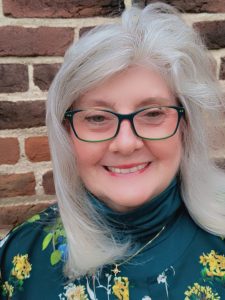For the love of history: A Q&A with Susan Emory

For more than 40 years, native Delawarean Susan Jackson Emory has been working as a historic site interpreter for the Delaware Division of Historical and Cultural Affairs, sharing her love for history with countless visitors through her current role at The Old State House in Dover and other volunteer work in her hometown of Milford for the Milford Historical Society. We caught up with Susan this fall to learn more about her and what keeps her going.
Tell us a bit more about you.
I am a native Delawarean, I am from Milford and have lived there all my life. My father built the Milford Airpark where I grew up, so I had a very interesting childhood. My sister, brother and I had to learn to fly before we were able to get our driver’s license. (Our father’s rule.) I have played handbells at my church for 25 years. I enjoy visiting other historic sites. I go to Florida often to visit my sister. I married my husband Ronnie in 1974 and we have two children, Zach and Hilary. In 2006 while at work, my husband died during a sea-faring accident.
I have a business degree, and my first job when I finished college was with the Delaware Department of Natural Resources and Environmental Control (DNREC). My position included being the administrative assistant for the Water and Air Resources Commission. I attended cabinet meetings, took the minutes, transcribed the minutes, and sent them to the cabinet members. I eventually left DNREC and began working at the Milford Airpark.
Describe your current position and work with the division.
I am a historic site interpreter for the Division of Historical and Cultural Affairs, working at The Old State House in Dover.

I began working for the Division of Historical and Cultural Affairs on July 1, 1980. I worked at all the Dover sites at that time: The Old State House, Museum Square (Johnson Victrola, Small Town Life and the Archaeology Museum), John Dickinson Plantation, and the Visitor’s Center which was located on the first floor of the Margaret O’Neill building behind The Old State House. When my son was born in 1981, my husband worked away a lot, so I did not work for a year and started again in 1982.
I had never talked in front of a group of people, but that quickly changed. I now enjoy telling people about the history of The Old State House and what the division is all about, especially when we have school groups; coming to our sites, this gives them a chance to learn about the history of the state they live in. We quite often dress in historic clothing, usually colonial but also other time periods depending on the programs we are presenting, which helps bring our stories to life. I am the one in charge of maintaining our historic clothing. The colonial clothing is in the basement of The Old State House, and the 1920s clothing is at the Johnson Victrola Museum.
What got you interested in a history career?
I had been volunteering for the Milford Historical Society in the late 1970s and soon became a member of their Board of Trustees in early 1980, and I continue to serve today. The Milford Historical Society maintains the Parson Thorne Mansion, the childhood home of John M. Clayton who built Buena Vista, one of the division’s properties. As a result, I was becoming more and more interested in Milford and Delaware history. I saw an advertisement for a historic site interpreter in Dover for the Division of Historical and Cultural Affairs. I thought it would be very interesting. I applied and here I am today!
What do you want people to know about the Old State House or other parts of the division’s work?
I want visitors to know that The Old State House was our first permanent capitol building in Dover. It was shared between The Delaware Legislative Council and the House of Assembly who met on the second floor, and the Kent County Courts meeting on the first floor. The building is here today because of Mable Lloyd Ridgely who saved The Old State House in the early 20th century.


